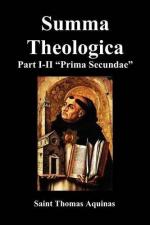The figurative cause is that the bread signifies Christ Who is the “living bread” (John 6:41, 51). He was indeed an ear of corn, as it were, during the state of the law of nature, in the faith of the patriarchs; He was like flour in the doctrine of the Law of the prophets; and He was like perfect bread after He had taken human nature; baked in the fire, i.e. formed by the Holy Ghost in the oven of the virginal womb; baked again in a pan by the toils which He suffered in the world; and consumed by fire on the cross as on a gridiron.
Reply Obj. 13: The products of the soil are useful to man, either as food, and of these bread was offered; or as drink, and of these wine was offered; or as seasoning, and of these oil and salt were offered; or as healing, and of these they offered incense, which both smells sweetly and binds easily together.
Now the bread foreshadowed the flesh of Christ; and the wine, His blood, whereby we were redeemed; oil betokens the grace of Christ; salt, His knowledge; incense, His prayer.
Reply Obj. 14: Honey was not offered in the sacrifices to God, both because it was wont to be offered in the sacrifices to idols; and in order to denote the absence of all carnal sweetness and pleasure from those who intend to sacrifice to God. Leaven was not offered, to denote the exclusion of corruption. Perhaps too, it was wont to be offered in the sacrifices to idols.
Salt, however, was offered, because it wards off the corruption of putrefaction: for sacrifices offered to God should be incorrupt. Moreover, salt signifies the discretion of wisdom, or again, mortification of the flesh.
Incense was offered to denote devotion of the heart, which is necessary in the offerer; and again, to signify the odor of a good name: for incense is composed of matter, both rich and fragrant. And since the sacrifice “of jealousy” did not proceed from devotion, but rather from suspicion, therefore incense was not offered therein (Num. 5:15). ________________________
FOURTH ARTICLE [I-II, Q. 102, Art. 4]
Whether Sufficient Reason Can Be Assigned for the
Ceremonies
Pertaining to Holy Things?
Objection 1: It would seem that no sufficient reason can be assigned for the ceremonies of the Old Law that pertain to holy things. For Paul said (Acts 17:24): “God Who made the world and all things therein; He being Lord of heaven and earth, dwelleth not in temples made by hands.” It was therefore unfitting that in the Old Law a tabernacle or temple should be set up for the worship of God.
Obj. 2: Further, the state of the Old Law was not changed except by Christ. But the tabernacle denoted the state of the Old Law. Therefore it should not have been changed by the building of a temple.
Obj. 3: Further, the Divine Law, more than any other indeed, should lead man to the worship of God. But an increase of divine worship requires multiplication of altars and temples; as is evident in regard to the New Law. Therefore it seems that also under the Old Law there should have been not only one tabernacle or temple, but many.




